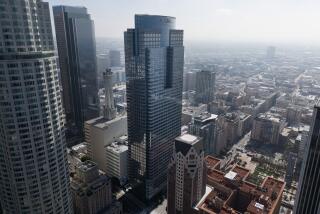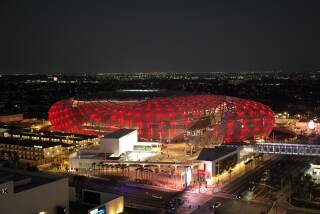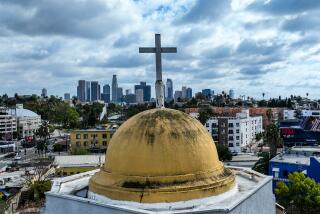Outdated Structure or Certified Landmark?
- Share via
OKLAHOMA CITY — For its fans, there’s no place like dome.
The Space Age half-sphere dazzled photographer Keith Ball when it went up one year after Sputnik did.
Then a Cub Scout from Seminole, Okla., he thought a glimmer from its gold roof was a magic sign that the big city was near.
Todd Scott’s mother worked there when she was a new high school graduate and it was Citizens State Bank. Now Scott, an architect, uses it to find his house from an airplane’s window.
“Everybody uses it to give directions in this part of town,” he said.
Yet the Gold Dome, as it’s known to locals, is without direction of its own.
Its corporate owner has asked permission to demolish the 43-year-old building it says is too big and in need of almost $2 million worth of repairs.
Bank One’s regional spokesman, Chris Spencer, said an inspector’s recent look found as much plugs as roof. “He said we have so much plastic up there we, in essence, have a second structure,” Spencer said.
Bill Schehing, the company’s Oklahoma president, said the dome has seven times the space Bank One needs for its planned branch.
“You have a building that has used up its useful life,” Schehing said.
Bank One’s plan to take out the dome and sell more than half of its lot to a drugstore chain has prompted weekly protests from dozens of pickets.
“I’ve been watching them blow up Oklahoma City since the ‘60s and I’m sick of it,” said Ball, a frequent picket.
Protesters have taken their cause to a Web site, released a song on the Internet and plastered billboards and bumper stickers around the city.
It’s somewhat amusing to Bob Roloff, the architect who designed the dome.
“It created a stir,” he said. “I’m sort of astounded to see it happen.”
The retired architect said the dome is not the first or the third in the country, as some have claimed. “I have a personal problem with it being called architecturally unique when it is not,” he said.
The state Historic Preservation Office has declared the dome eligible for the National Register of Historic Places even though it hasn’t been around for the standard 50 years.
Architectural historian Jim Gabbard said the dome is significant because businesses rarely used domes. The structures’ main uses were military buildings or exhibition halls, he said.
Gabbard said he has had to debunk some myths surrounding the dome. It was not, for example, designed by visionary architect Buckminster Fuller.
Fuller, after studying such natural patterns as honeycombs, is credited with inventing the interlocking panel system that resembles what is now used in the international space station’s unfolding solar collectors.
The architect believed in the idea so much that he thought a dome several miles in diameter could be built over New York City to shelter its residents from bad weather.
“That was a dream, and he was trying to show this dream could be done,” Gabbard said.
One of the reasons the dome is worth keeping, he said, is because it is evidence of this scientifically optimistic era so different from today.
Roloff said the bank leaders who hired his firm intended for the dome to be dismantled after an unspecified number of years. The same process used to assemble the 625 diamond-shaped panels could be reversed to take them apart, he said.
“Maybe they can make everybody happy by moving it somewhere else,” he said.
Schehing said the company, which inherited the building in a 1997 acquisition, is willing to donate the 20-ton dome to the community if it can be assembled elsewhere.
Bank One has postponed its demolition request while the options are considered. It has said this will probably be the final delay. The banking company gave the building a reprieve this summer and sought another buyer for the dome. A deal with a local pain remedy manufacturer fell through.
John Yoekel, chairman of a committee created by the city to come up with a solution, said he doesn’t think relocation would have the peacemaking effect Bank One wants.
“I think it was a good-faith attempt,” he said, but added that he has told the company it could end up being “a daily reminder that you moved a landmark structure that [residents] wanted to keep.”
Instead, Yoekel, president of a local oil and gas production company, said he’s optimistic that another use can be found in the next few weeks.
“We can have a save for a change,” he said. “We’ve told them we’re in uncharted waters here. We’ve never saved a landmark in Oklahoma City before. Please give us time.”
More to Read
Sign up for Essential California
The most important California stories and recommendations in your inbox every morning.
You may occasionally receive promotional content from the Los Angeles Times.













